surfresearch,com.au
 |
surfresearch.com.au
kingston :
africa, 1874
|
W. H. G. Kingston :
Great African Travellers, 1874.
Extracts from
W.H.G. Kingston: Great African Travellers,
From Mungo Park To Livingstone And Stanley.
George Routledge and Sons, London, 1874.
http://www.hellenicaworld.com/Africa/Literature/WHGKingston/en/GreatAfricanTravellers.html
Introduction.
These references
were identified by Hervé
Manificat in December 2015.
Most of the water craft detailed in the various accounts are
dug-out canoes, but also note the rafts of ambatch-wood of the
White Nile and the gourd rafts used on Lake Chad.
Importantly, the book gives several accounts of hunting hippopotamus with a barbed-spear (harpoon) and
attached float, the same method used by generations of off-shore
whalers.
The earliest evidence of human
interaction with hippos comes from butchery cut marks on hippo
bones at Bouri Formation dated around 160,000 years ago.
https://en.wikipedia.org/wiki/Hippopotamus#Hippos_and_humans
Chapter Nine: Journey of the Landers, and their voyage down the Niger, 1830.
|
Krumen and their Canoes.
This definitely a
coastal scene, however, all the canoe
references in the text appear to be inland on lakes
or rivers, with a brief account of landing at Quillimane in Chapter 20, below.
Hervé
Manificat notes that the image seems to show mosquito-canoes of Batanga.
See
Mary
K. Kingsley: Canoes
and Fishing, West Africa, 1899.
|
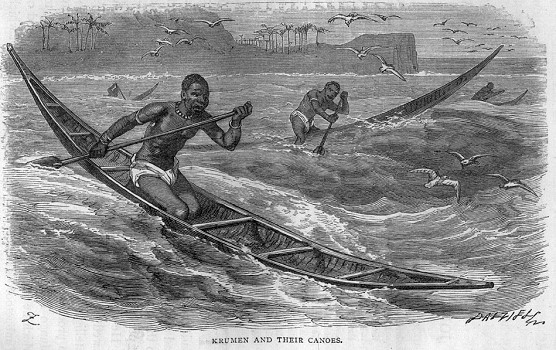
|
Chapter Eleven:
Travels of Dr Barth, continued.
|
Fishing Scene [Lake Chad]
The inhabitants on the shores of the lake subsist
chiefly on fish, which they catch in an ingenious
way.
The fisherman takes two large gourds, which he
connects by a bamboo of sufficient length to allow
him to sit astraddle between them.
He then launches forth on the water, taking his
nets.
These are weighted by little leathern bags,
filled with sand and supported by bits of bamboo.
Having shot his net, he paddles about with his
hands, driving the fish into it, and then, taking
them out, kills them with a club, and throws them
into the gourds
When they are full, he returns to the shore.
|
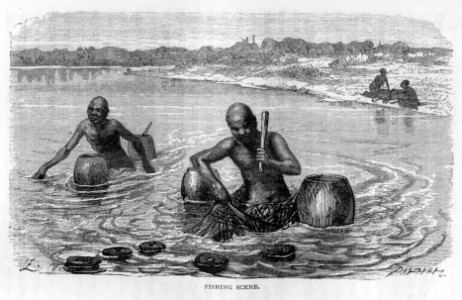
Fishing
Scene
|
Chapter Eighteen:
Travels of Dr Livingstone—first expedition.
Leaving the wagons in charge of the natives, with the
exception of a small one which proceeded along the bank,
Dr Livingstone embarked in one of their canoes.
Frail as are the canoes of the natives, they make long
trips in them, and manage them with great skill, often
standing up and paddling with long light poles.
They thus daringly attack the hippopotami in their
haunts, or pursue the swift antelope which ventures to
swim across the river.
Canoes
... |
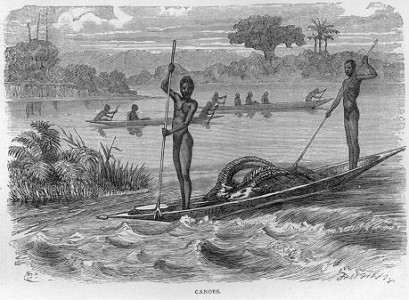
|
The natives inhabiting the banks of the rivers
falling into Lake Ngami are famed for their skill in hunting the
hippopotamus.
In perfect silence they approach in their light canoes, and
plunge their sharp spears, with thongs attached, into the back
of one of the huge creatures, which dashes down the stream,
towing the canoe at a rapid rate.
Thus [three
illustrations] the animal continues its course, the hunters
holding on to the rope, till its strength is exhausted, when,
other canoes coming up, it is speared to death.
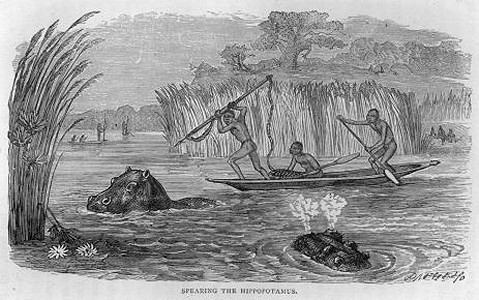
Spearing the Hippopotamus
Frequently, however,
the hippopotamus turns on its assailants, bites the
canoe in two, and seizes one of them in its powerful
jaws.
When they can manage to do so, they
tow it into shallow water, and, carrying the line on
shore, secure it to a tree, while they attack the
infuriated animal with their spears, till, sinking
exhausted with its efforts, it becomes their prey.
The Final
Attack.
|
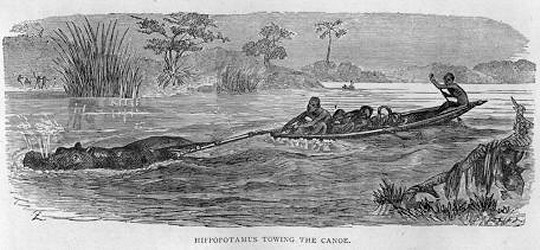
Hippopotamus
towing the canoe.
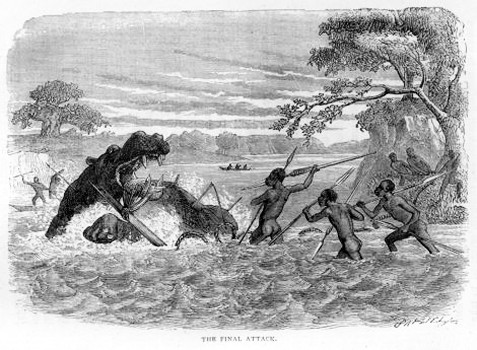
|
Chapter Twenty:
Travels of Dr Livingstone, continued.
The party now directed their course to the Zambesi near its
confluence with the Kafue.
...
Pursuing their course down the left bank, they came opposite the
island of Menyemakaba, which is about two miles long and a
quarter broad.
Besides its human population it supports a herd of upwards of
sixty buffalo.
The comparatively small space to which the animals have confined
themselves shows the luxuriance of the vegetation.
The only time that the natives can attack them is when the river
is full and part is flooded: they then assail them from their
canoes.
...
After waiting
about six weeks at Quillimane, HM brig “Frolic” arrived, on
board which he embarked.
A fearful sea broke over the bar, and the brig was rolling so
much that there was great difficulty in reaching her deck.
Poor Sekwebu looked at his friend, asking: “Is this the way
you go?”
The doctor tried to encourage him; but, though well acquainted
with canoes, he had never seen anything like it.
Chapter Twenty Two:
Dr Livingstone’s expedition to explore the Zambesi,
continued.
It [Lake Nyassa] is visited by sudden and
tremendous storms.
One morning the sea suddenly rose around them, preventing them
from advancing or receding, as the tremendous surf on the beach
would have knocked their light boat to pieces, while the waves
came rolling on in threes, their crests broken into spray. Had
one of them struck the boat, nothing could have saved her from
being swamped.
For six hours they remained at anchor a little from the shore,
thus exposed to the fury of the gale.
The crew became sea-sick and unable to keep the boat’s head to
the sea, while some of their party who had remained on shore
watched them, the natives every moment exclaiming: “They are
lost! they are all dead!”
After this, every night they hauled the boat up on the
beach; and, had it not been supposed that these storms were
peculiar to one season, they would have given the Nyassa the
name of the “Lake of Storms.”
Chapter Twenty Three:
Travels of Sir Samuel and Lady Baker.
After spending
three months at Son, he set out for the Settite
River, he and his wife crossing the Atbara River on
a raft formed of his large circular sponging bath
supported by eight inflated skins secured to his
bedstead.
A party of the Aggageers now joined him.
Among them was Abou Do, a celebrated old
hippopotamus hunter, who, with his spear of trident
shape in hand, might have served as a representative
of Neptune.
The old Arab was equally great at elephant hunting,
and had on the previous day exhibited his skill,
having assisted to kill several elephants.
He now divested himself of all his clothing, and set
out, taking his harpoon in hand, in search of
hippopotami.
This weapon consisted of a steel blade about eleven
inches long and three-quarters of an inch in width,
with a single barb.
To it was attached a strong rope twenty feet long,
with a float as large as a child’s head at the
extremity.
Into the harpoon was fixed a piece of bamboo ten
feet long, around which the the rope was twisted,
while the buoy was carried on the hunter’s left
hand. |
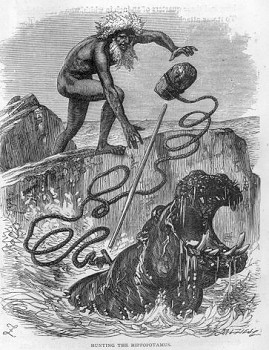
|
After proceeding a couple of miles, a herd of hippopotami
were seen in a pool below a rapid surrounded by rocks.
He, however, remarking that they were too wide-awake to be
attacked, continued his course down the stream till a
smaller pool was reached.
Here the immense head of a hippopotamus was seen, close to a
perpendicular rock that formed a wall to the river.
The old hunter, motioning the travellers to remain quiet,
immediately plunged into the stream and crossed to the
opposite bank, whence, keeping himself under shelter, he
made his way directly towards the spot beneath which the
hippopotamus was lying. “Stealthily he approached, his long
thin arm raised, with the harpoon ready to strike.
The hippopotamus, however, had vanished, but far from
exhibiting surprise, the veteran hunter remaining standing
on the sharp ledge, unchanged in attitude.
No figure of bronze could be more rigid than that of the old
river king, as he thus stood, his left foot advanced, his
right-hand grasping the harpoon above his head, and his left
the loose coil of rope attached to the buoy.”
“Three minutes thus passed, when suddenly the right arm of
the statue descended like lightening, and the harpoon shot
perpendicularly into the pool with the speed of an arrow.
In an instant an enormous pair of open jaws appeared,
followed by the ungainly head and form of a furious
hippopotamus, who, springing half out of the water, lashed
the river into foam as he charged straight up the violent
rapids.
With extraordinary power he breasted the descending stream,
gaining a footing in the rapids where they were about five
feet deep, thus making his way, till, landing from the
river, he started at full gallop along the shingly bed, and
disappeared in the thorny jungle.
No one would have supposed that so unwieldy an animal could
have exhibited such speed, and it was fortunate for old
Neptune that he was secure on the high ledge of rock, for
had he been on the path of the infuriated beast, there would
have been an end of Abou Do.”
The old man rejoined his companions, when Mr Baker proposed
going in search of the animal.
The hunter, however, explained that the hippopotamus would
certainly return after a short time to the water. In a few
minutes the animal emerged from the jungle and descended at
full trot into the pool where the other hippopotami had been
seen, about half a mile off.
Upon reaching it, the party were immediately greeted by the
hippopotamus, who snorted and roared and quickly dived, and
the float was seen running along the surface, showing his
course as the cork of a trimmer does that of a pike when
hooked.
Several times the hippo appeared, but invariably faced them,
and, as Mr Baker could not obtain a favourable shot, he sent
the old hunter across the stream to attract the animal’s
attention.
The hippo, turning towards the hunter, afforded Mr Baker a
good chance, and he fired a steady shot behind the ear.
The crack of the ball, in the absence of any splash from the
bullet, showed him that the hippopotamus was hit, while the
float remained stationary upon the surface, marking the spot
where the grand old bull lay dead beneath.
The hunter obtaining assistance from the camp, the
hippopotamus, as well as another which had been shot, were
hauled on shore.
The old bull measured fourteen feet two inches, and the head
was three feet one inch from the front of the ear to the
edge of the lip, in a straight line.
Though hippopotami are generally harmless, solitary old
bulls are sometimes extremely vicious, and frequently attack
canoes without provocation.
Chapter Twenty Four: Travels of Sir
Samuel and Lady Baker, continued.
On the 2nd of January
they were sailing past the country inhabited by the
Shillooks, the largest and most powerful black tribe on
the banks of the White Nile.
They are very wealthy, and possess immense herds
of cattle; are also agriculturists, fishermen, and
warriors.
Their huts are regularly built, looking at a
distance like rows of button mushrooms.
They embark boldly on the river in their raft-like
canoes, formed of the excessively light ambatch-wood.
The tree is of no great thickness, and tapers
gradually to a point.
It is [illustration] thus easily cut down, and,
several trunks being lashed together, a canoe is quickly
formed.
A war party on several occasions, embarking in a
fleet of these rafts, have descended the river, and made
raids on other tribes, carrying off women and children
as captives, and large herds of cattle. |
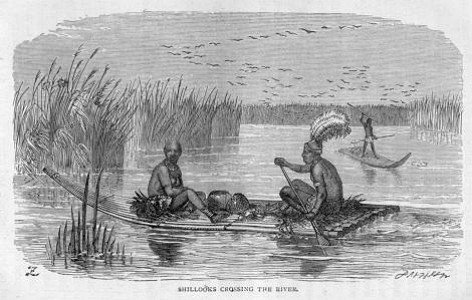
Shillooks crossing
the River
|
|
Fishing
Canoes, Cape Verde
All persons who have voyaged down the West Coast of
Africa will know that Cape Verde is one of the few
prominent places which are sighted by the steamers.
Land is always a welcome spectacle to travellers
on a long voyage, and at this point the interest is
often increased by the appearance of natives in
fragile-looking canoes, tossed up and down like feathers
on the huge swell, which invariably prevails on that
part of the coast.
It seems wonderful that men should be able to fish
from such frail vessels, yet they have been seen to
stand up in them, holding up their fish for sale to
passing ships, without apparently any difficulty of
preserving their balance.
The West Coast
of Africa -
Fishing Canoes off Cape Verde, 1880.
|
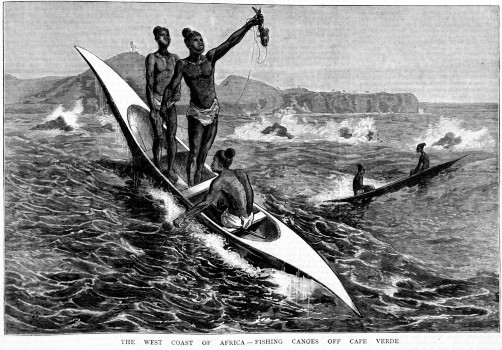
|
The Graphic: An
Illustrated Weekly Newspaper London, vol. 22 December 25,
1880, page 653.
http://www.old-print.com/cgi-bin/item/J6971878564/search/31-Old-Original-Antique-Victorian-Print-West-Coast-Africa-Fishing-Canoes-Off-Cape-Verde-Sketch-1880-564J697#
Comments:
Line fishing from canoes. Also shows loin cloths and hairstyles
of fishermen, and gives some idea of the heavy surf.
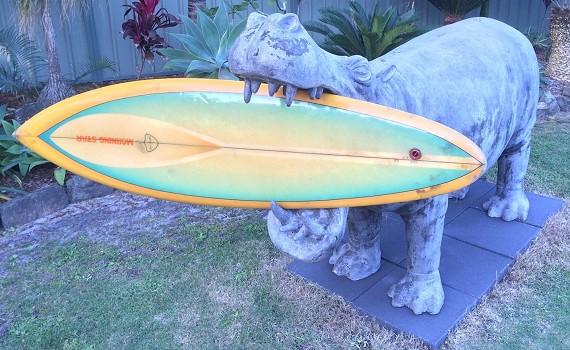
Hippopotamus and Morning Star Surfboard,
2014?

surfresearch.com.au
Geoff Cater (2016) : W.H.G. Kingston: Great African
Travellers,
1874.
http://www.surfresearch.com.au/1874_Kingston_Africa.html
Herve, 0216:
Egypt
Stunt Nile Cascades
Speaking of waves in the heart of Egypt, several hundred kilometers
from any sea? Yet, the Nile, the world's largest river, which, from
antiquity to the 20th century, has mobilized hundreds of geographers
and explorers wanting to map its course and find its source was a
rushing river lined with formidable cataracts . The Aswan population
was accustomed to brave the first one on improvised floats to the
great entertainment of travelers since ancient times, as the Greek
geographer Strabo, who visited Egypt in 25 BC.
A little over Éléphantine1, is the small cataract, where we see
people riding on skiffs give a sort of show to major country.
Cataract is a hill of rock in the middle of the Nile, united at the
top and covered by the waters of the river; it ends with a
precipice, from which water rushes impetuously from either side,
toward the coast, there is a navigable bed; drivers are lured
towards the cataract, then rush skiff with them, without them no
harm happens.
The traveler Joseph Joubert, who was in Aswan in the late 19th notes
identical scenes:
As soon as we exceeded Aswan, all vegetation disappears; the view is
limited by the jagged rocks which bristle on both banks of their
dark masses, while the Nile, pressed into narrow corridors, rumble
and seethe; repressed vortices roll and
pirouette, it's a shock currents collide, whip, breaking and
foaming furious. The river wrath jumps, leaps and rushes into a wild
ride, dizzying; it comes down to breakneck stairs slippery cataracts
and tumbles fast bleachers at full gallop. Our boat slips amid the
reefs, led by the skilful hands of the pilot, while naked kids (...)
face the horse passes on a tree trunk or a bundle of reeds, tour of
a singular force audace.i
In correspondence, the illustrious writer Gustave Flaubert is also
struck by this show in March 1850:
To cross the river, the locals take it as follows: we begin by
removing his shirt that is rolled into a turban on his head, is
mounted astride two bunches of reeds bound together and ending in a
point at each end; then, with an oar, water is pushed alternately
right and left. In the middle of the water is thus seen these black
newts who go quietly, legs crouched before them on their singular
basket. "(...) The vagabond Nile rolls on its shores! The day before
yesterday we had cataracts or, rather, the cataracts of the first
cataract, because this is a whole country. Naked niggers cross the
river on palm trunks, rowing with both hands. They disappear into
the whirlwinds of foam faster than a black ball of wool thrown into
a mill stream. Then the tip of their tree trunk (on which they are
lying) rears like a horse. We see them, they come to us and boarded;
Water trickles over their smooth bodies as on the bronze statues of
fontaines.ii
Tourism in Egypt was a reality from the 19th century. Many travelers
bring us some interesting details about the forgotten practice of
cataract descent:
1 located on the Ile river up to Aswan.
(Now in the descent of the boat cataract) other Nubians were
following us current on the banks - or falling on the water, playing
in the river - sometimes swimming and diving around us - sometimes
sitting or riding on a palm trunk. They escorted us like Tritons,
these sea gods of mythology grecque.iii
The Nile has waves like the sea. (...) The troop of Nubians who was
there suddenly disappeared. I saw something fantastic float on
water, and I could not believe my eyes: it was the Nubians riding on
tree trunks that were going to swim to the big waterfall. They
disappeared into the waves; they went on their surface; they slipped
like crocodiles between the waves and the rocks; - Finally I
breathed, they reappeared all safe. This often perished in those
games certainly, I had not provoqués.iv
As in Hawaii, children and adults practice together:
We approach the shore and climb a hundred paces away, a mound ending
with a rock, top 8 to 10 meters and overlooking the river. From that
high point, a dozen Nubians, big fellows naked, children, young men,
rushed into the furious waves, dive and reappear a little further,
astride a piece of wood they don ' have not abandoned; then all
these shiny black skin escorted us to the boat, screaming, leaping,
shouting for the inevitable bakchich.v
Some even hold water:
Two children riding on palm trunks, that imagination can take to the
dolphins, they are hidden by the waves, just start their games,
hoping any currency in payment of the show. They descend standing
aside, swimming, diving, disappearing to the point of alarm us, and
joyful singing and reappear; and all along a tortuous slope, noisy,
covered with breakers of bubbling and foaming, and in the bed of
which we feel there is enormous rochers.vi
But this form of ancient and amazing water slides abruptly
disappeared. The construction of the first Aswan dam in 1902
annihilated the first cataract and quick and made disappear the same
time the "newt" Egyptian and Nubian. It also created the threat of a
giant wave:
In some circles, the Aswan reservoir is heavily criticized and
questioned its strength. A famous archaeologist told me: "My belief
is that it will not stand. (...) Imagine, if you can what will
happen when the dam bursting, let through a wave of hundred billion
cubic meters of water, knocking himself on the Nile Valley, will
take with it the towns and villages and annihilate the entire
population. "vii
Going up above the river, the Shilluk ethnic group encountered which
boats and their ability to use the won the admiration of many
explorers in search of the Nile sources. The Shillooks did not
hesitate to hunt dangerous hippo aboard their "stand-up canoe" made
of cane and involving users balance their wonders:
The three major occupations of the race (Shilluk) are: fishing,
hunting and war. (...) They feel strong hippo to the huge amount of
meat, fat and buff it provides. They make him a fierce war or night
on land, bravely cutting his retirement when he came out to pasture
or in the dugout by hunting spear as the whale. A piece of wood that
serves to buoy the weapon, to track the wounded animal when it dives
and fled. Whenever she appears to breathe, the spears rained until
qu'épuisée by blood loss, she succumbs. But it is not without
vicissitudes and safe; often because of a shoulder strike the great
pachyderm capsized the canoe frail and crocodiles are ready for
revenge.
Curious, this canoe the Shilluk. The abobo, as it is called, is
neither more nor less than an armful of big rushes of ambatch linked
flat shaped tiny raft, and narrow peak towards the end which forms
the front. Fragile and thin is it that one man can take place; so
light that landing the Shilluk load as a feather on his shoulder and
brings the village to dry. Because the ring is very spongy and
quickly becomes heavier. These canoes so similar to cane shields
Seeing them for the first time supported the boxes where they were
drying with spears, I took them as such. We understand that the
slightest wrong movement of the paddler capsizes this frail bark on,
but the hardest part is yet to hop without spilling. It is an art to
perform this delicate boarding. The Shilluk starts poking spears in
the reeds of the dugout for a free hand into the water and pushed
his skiff before him. Then when he wanted grabs abeam and annoying
just the right balance by a miracle, natural body weight that would
rely too much on one side, a recovery he jumps on his knees in the
middle . Under the pressure of the weight, the boat sinks like a
cork when a frog jumps, but soon returns to the surface, thin sheet
with this great silhouette of a man kneeling on his heels, and now
immobile for hours. Only arms wave digging water right and left of
the rhythmic effort of a single paddle need to pass each time from
one hand to another, juggling without letting go ever, because there
is no alternative and we would go adrift. And kneeling on wet
rushes, and almost in the water, far we really believe that sitting
at the surface of the river, they slip it quietly among
crocodiles.viii










